Engadget has been testing and reviewing consumer tech since 2004. Our stories may include affiliate links; if you buy something through a link, we may earn a commission. Read more about how we evaluate products.
Samsung Galaxy S20 series hands-on: 5G across the board (sort of)
Can 5G and some ambitious cameras make these phones essential?
If you were planning to buy a premium Android smartphone this year, you can rest easy knowing they'll all come with more or less the same things. A speedy, new chipset with gobs of RAM? Yep. An at least mildly tweaked build of Android 10? Sure. A few too many cameras? You get the idea. Samsung understands this all too well, which explains why it's leaning so hard into the whole "age of experience" angle it first laid out at CES this year -- as far as the company is concerned, a device's true value doesn't lie in just the hardware; it's in the things that hardware allows you to do. Suffice to say, the $999 Galaxy S20, $1,199 S20+ and $1,399 S20 Ultra allow you to do a lot.
We got to spend a little hands-on time with all three devices ahead of today's launch event, and as usual they made some strong first impressions. Sure, in many ways, they don't stray too far from Samsung's proven flagship formula, and some people simply won't find enough value here to warrant an upgrade. If you've been itching for more 5G support, though, or if camera performance is high on your list of priorities, these new smartphones just might be must-haves. Emphasis on "might."
The basics
About this time every year, I play with Samsung's new stuff and say something along the lines of "these devices represent the company at the top of its smartphone-making game." It's a bit trite now, but still undeniable: The Galaxy S20 series feels impeccably well-made. With the exception of the Ultra (which I'll get to in a bit), the S20s are surprisingly light, too -- no small feat considering the components involved. The standard S20 packs a 4,000mAh battery and a 6.2-inch screen that runs at resolutions as high as Quad HD+, while the larger S20+ has a 4,500mAh battery and a 6.7-inch display.
These screens, by the way, are just fantastic. (I'm sure you're shocked to hear that about the reigning champion of smartphone displays.) These are Dynamic AMOLED panels, just like last year, but the camera cutouts are now even smaller and center aligned instead of off in a corner. You can expect the usual sumptuous colors and deep blacks that Samsung's screens are known for, and HDR10+ support is a plus, but the biggest difference this year is the fact that they can all run at refresh rates as high as 120Hz. (The OnePlus 7 Pro and Pixel 4, by comparison, top out at 90Hz.)
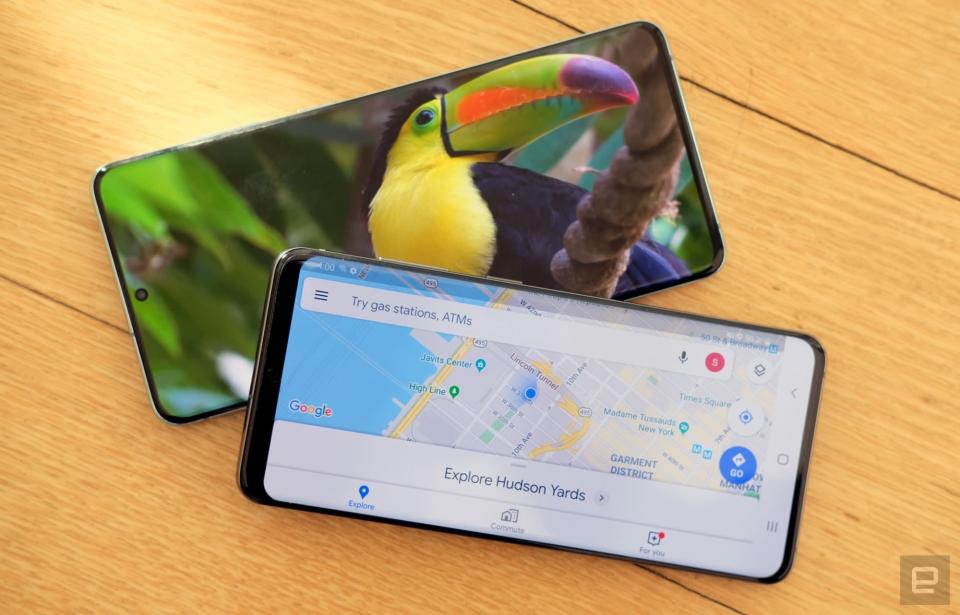
This is, in short, a big deal. For the uninitiated, high refresh rates mean motion on-screen looks very smooth, almost shockingly so compared to traditional displays. Few devices out there right now have screens that update as quickly as this one does, and most of them are IPS LCDs, so they lack the sort of visual verve that comes with OLED panels. I know it's early in the year and the rest of the industry could follow suit, but for now, Samsung's S20 screens have spoiled me. There is, however, one caveat: You'll only get that super-buttery screen performance if you set the S20's display resolution to Full HD+, or 1080p-ish. Samsung wouldn't explicitly say why, but I have to assume it's because pushing more pixels than that would probably obliterate the battery.
These screens are also the focus of one of Samsung's biggest design changes this year. Rather than curving the displays down the sides of the phones a bit, Samsung essentially left them flat. That's important to note for two reasons. First, the Galaxy S20 series looks ever-so-slightly less striking than before. There's just something cool about screens that curve away from you, which I guess explains why so many companies are going nuts over waterfall displays now. More importantly, this somewhat conventional design means you're much less prone to accidentally touching the screen with the side of your hand. I'm not kidding when I say these errant touches were annoying enough to keep me from using a Samsung phone long-term, and I couldn't be happier for this change.
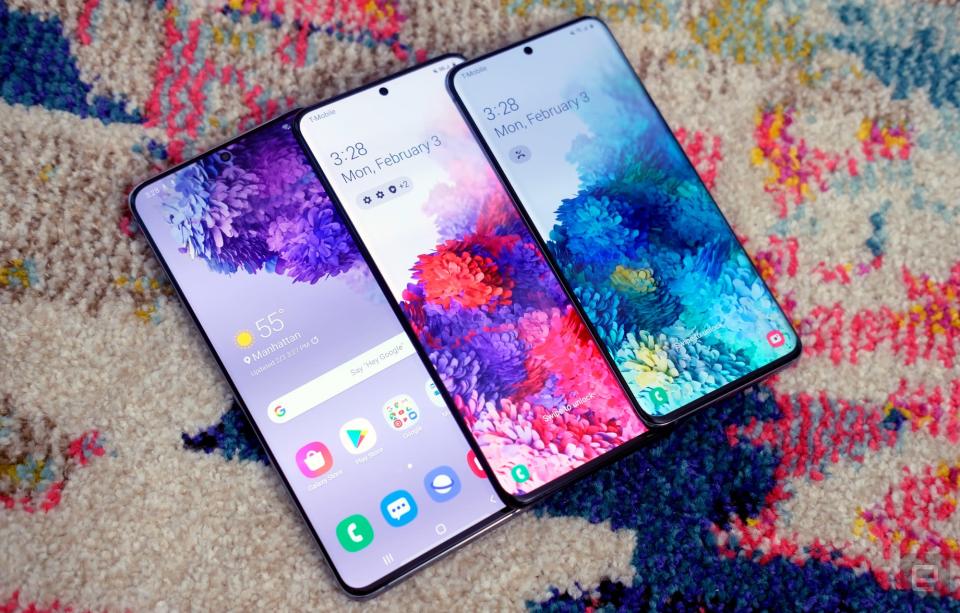
As usual, these three new Galaxy phones share a common foundation: Each of them use either the new Snapdragon 865 chipset or a Samsung Exynos chip depending on your home market, along with at least 12GB of RAM and 128GB of storage. The difference in performance can be pretty hard to suss out when you're just jumping between apps -- we couldn't test games or sideload benchmark apps on these demo models -- but we're looking forward to seeing what these devices are really capable of in due time.
Performance is one of the few areas where we're likely to see little difference between Samsung's phones and the rest of the competition since they're all going to wind up with the same chipset, but Samsung has added a few bits they hope will give it an edge. The most interesting? You'll be able to store up to five apps (including games) entirely in memory, so you can pick up where you left off more quickly.
All versions of the S20 also ship with Android 10 obscured somewhat by Samsung's updated One UI 2.0 interface, which has already started to roll out to existing Samsung devices. One UI has always been a love-it-or-hate-it sort of thing, but I've slowly come around in recent years -- it's satisfyingly clean compared to what Samsung used to do, and packs plenty of nips and tucks to clean up to ensure everything plays nice with Google's own software.
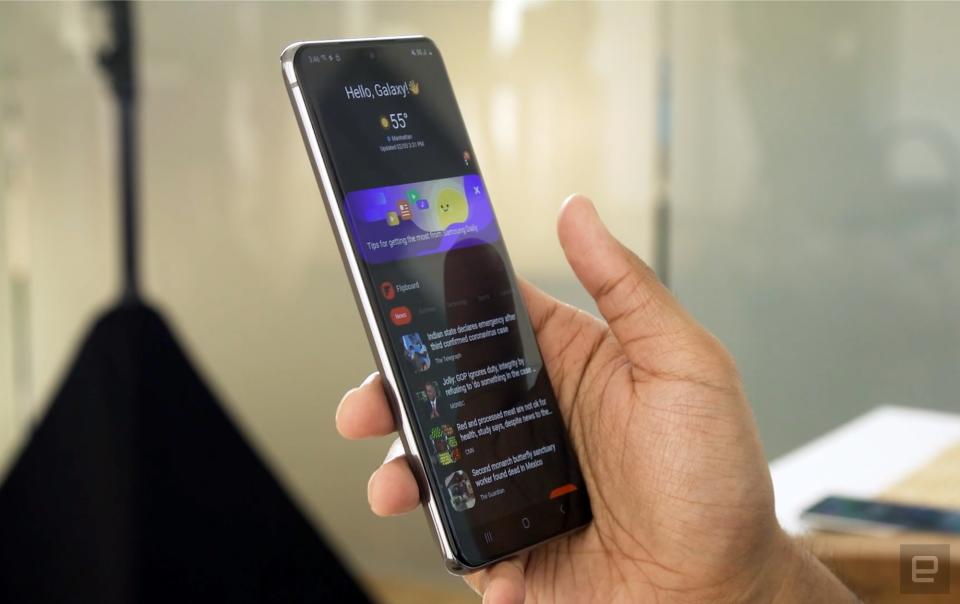
The Ultra difference
Unlike last year with the S10e, there is no cheaper version of the S20. Instead, we've seen Samsung slash prices for the entire S10 family, and release "Lite" versions of its popular Galaxy S10 and Note 10. With the "affordable flagship" base amply covered, Samsung had the freedom to run in the opposite direction and build a phone that's essentially excess incarnate.
While the other S20s feel as manageable in the hand as the models that came before, the Ultra is a full millimeter thicker than the S20+ and 34 grams heavier. That doesn't sound like a dramatic variance, I'll admit, but I promise you'll feel the difference when you pick the Ultra up. It is, for lack of a more elegant phrase, a chonker. Thankfully, Samsung is putting that extra girth to good use -- beyond the bigger, 6.9-inch Dynamic AMOLED screen and the huge camera hump on its back, there's also a 5,000mAh battery tucked away inside. The Ultra also packs a significantly different camera setup than the other two Galaxy S20s, including a 40-megapixel front-facing camera (for some reason) and a more ambitious zoom system around back -- we'll get to that, though.
All of this excess comes at a cost, though: The base Ultra with 12GB of RAM and 128GB of storage will cost you $1,400, and there's an even higher-end model if you'd rather bump yourself up to 16GB of RAM and 512GB of storage. (Note: All versions of the Galaxy S20 have microSD card slots, so you won't need to fret much over running out of room.)
5G for all (sort of)
This is the year 5G will really start to matter for regular people, so it's no surprise that Samsung is going wide with support for these super-fast wireless networks. Last year, if you really wanted a 5G-friendly Galaxy S10, you only had one choice: the super-sized Galaxy S10 5G, with its enormous battery and relatively exorbitant price tag. Not this time.
Every version of the Galaxy S20 has 5G support baked into it, though only the bigger S20+ and S20 Ultra support both sub-6 and mmWave networks. The smaller, standard S20 is purely a sub-6 device, which means this version of the phone will never play nice with the super-fast-but-geographically-limited mmWave networks that are slowly coming online around the US. If you absolutely can't abide the S20+ or Ultra's bigger bodies and need a new Android phone, the S20 will certainly do, but it's hard to recommend since it's not nearly as future-proof as the others.
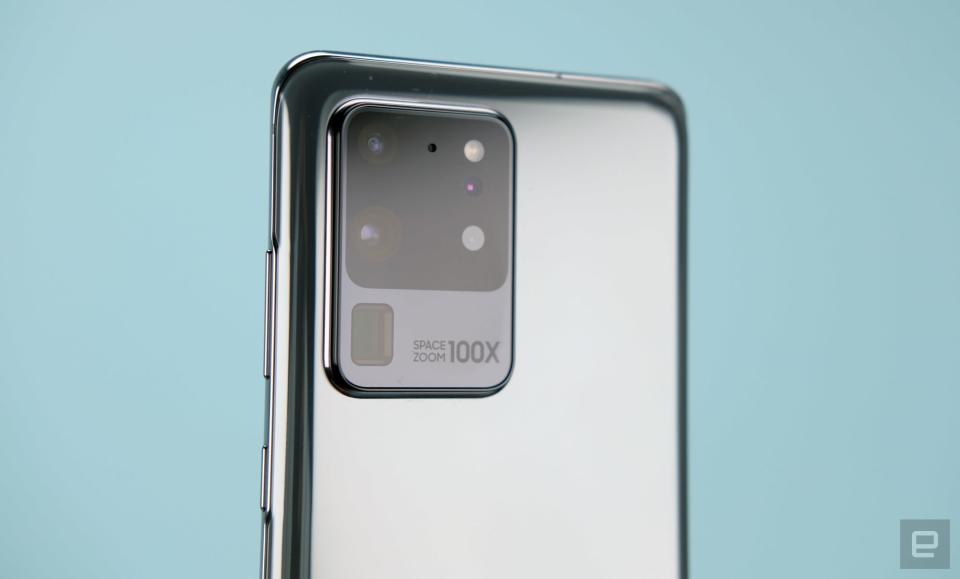
Ambitious cameras
Samsung is convinced that improved cameras are the biggest reason people upgrade their phones, so naturally, that's where most of the work seems to have happened. Here's what we're working with:
The Galaxy S20 has a 10-megapixel front-facing camera, and an improved triple-camera around back. Most of the time, you'll be using the standard 12-megapixel wide camera with its f/1.8 aperture, which so far has taken some fantastic photos. Also around back is a 12-megapixel ultra-wide camera that captures 120 degrees of whatever's in front of it, plus a 64-megapixel, f/2.0 telephoto camera.
The S20+ uses the exact same cameras as the standard S20, but with an added rear depth sensor.
The S20 Ultra is in a league of its own. In addition to the 40-megapixel front-facing camera I mentioned earlier, it uses a whopper of a 108-megapixel sensor as its standard wide camera. While you can shoot at that full resolution if you wanted to, you're generally better off shooting in the default, pixel-binned mode that produces 12 megapixel shots. The 12-megapixel ultra-wide camera is the same you'll find in its smaller siblings, but surprisingly, Samsung went with a 48-megapixel, f/3.5 telephoto sensor.
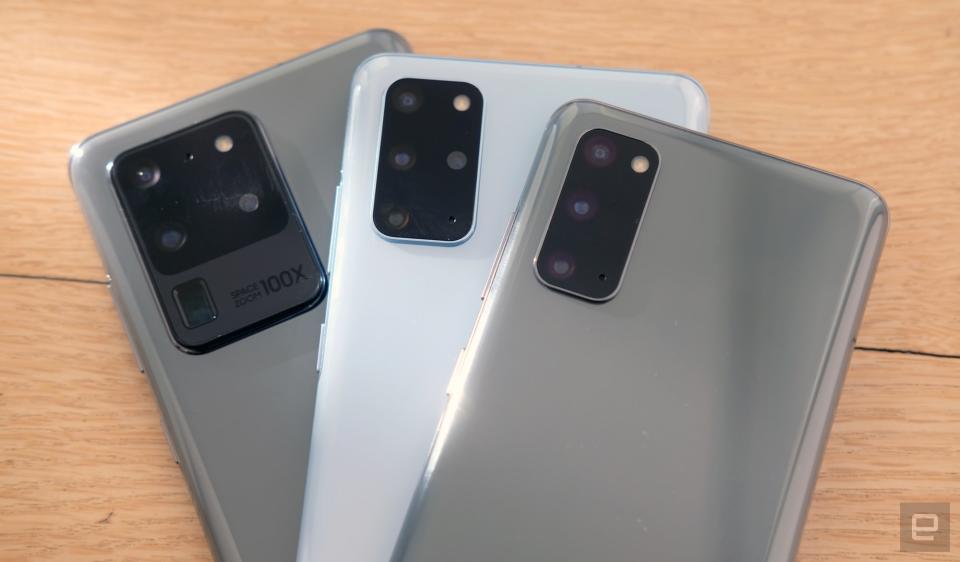
Now, we didn't get very much time to play with these cameras, but they produced some pretty great-looking photos -- the pixel-peeping will sadly have to wait a while. While it's tough to say right now whether Samsung's overall photo quality has improved, I think it's fair to say the company is getting more ambitious in how they use these cameras. Need proof? Just look at Space Zoom.
The S20 and S20+ can optically zoom in 3X on a subject, and the Ultra can push in 4X -- not bad at all, but hardly game-changing. By combining that optical zoom with a serious dose of algorithmic stabilization and correction, though, the two smaller S20s can Space Zoom up to 30X for situations when you absolutely need to, uh, shoot photos of your friends from across big rooms. Honestly, the best thing I can say about Space Zoom on the S20 and the S20+ is that it works -- whether the soft, smudgy results are worth the effort is another question entirely. (I'm on the fence, myself.)
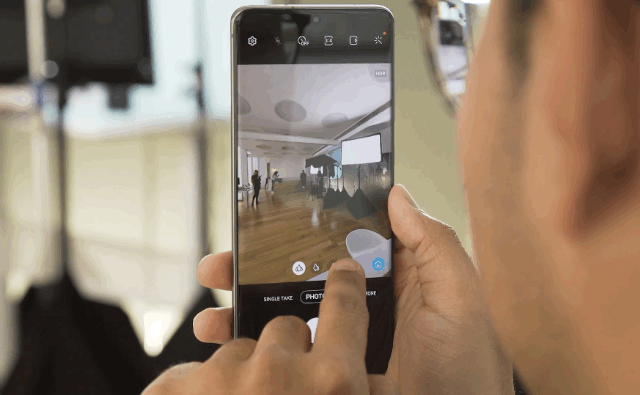
The S20 Ultra's Space Zoom system is even more absurd: Its telephoto sensor shoots at a lower resolution than the regular S20s, but support from the 108-megapixel wide camera means you can shoot mostly lossless 10X photos. If you really wanted to push things, though, you can Space Zoom in on your subject up to a staggering 100X, which, to be clear, you should never really do.
I get that the Ultra is meant to be the pro-grade model here, and that excess is supposed to be its greatest virtue. And yes, it's tremendously cool to line up a shot of your friend standing across the room, tap one button, and see the camera whooooosh through space to show you the food stuck in his teeth. (This is a 100 percent true story, and I will never forget it.) Here's the thing, though: Framing a photo while you're in the 100X zoom mode is very nearly impossible because of how much the camera magnifies every one of your hand's minute movements. And the resulting photos? They're fuzzy, over-processed, and far from satisfying. I'm sure someone will find this 100X zoom useful, and future updates might improve on what I saw on these pre-release models. For now, though, you'll get the best results if you don't zoom past 30X.
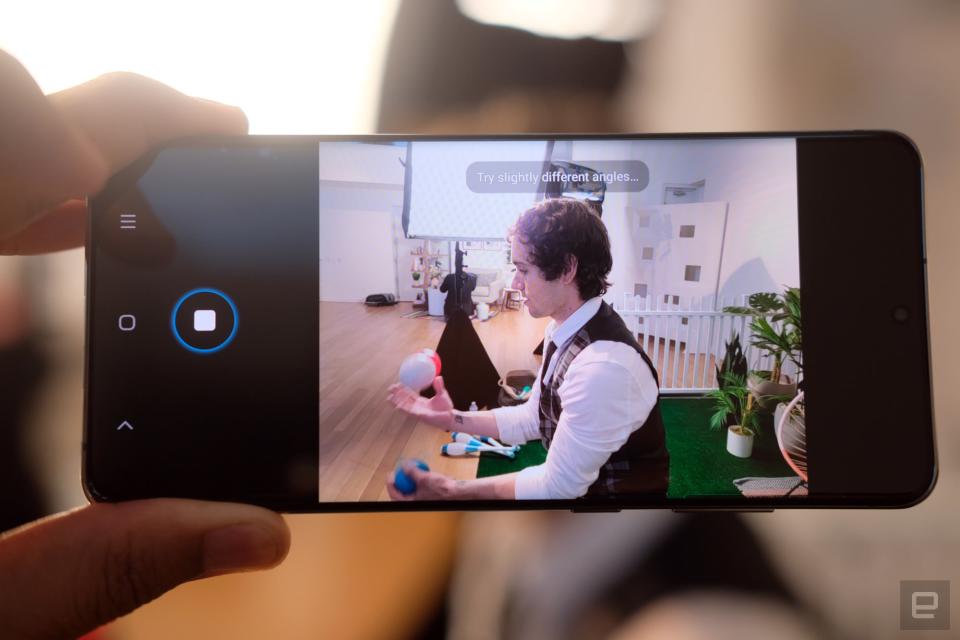
Thankfully, some of Samsung's other new camera features are more helpful right out of the gate. Single Take is probably the best of them -- rather than agonize over which camera to use for a specific shot, Single Take removes the guesswork and spends up to 10 seconds shooting with a bunch of them. The end result: a slew of stills and short video clips meant to give you a full sense of what's going on in front of you.
The feature relies on a handful of AI tools Samsung built in the past, so among your shots, you'll see one the S20 deems "the best" based on how it's framed, some wider-angle photos that capture more of the background, plus maybe a couple neat, looping video clips. (This feature works with the front-facing camera too, if you're an extreme fan of your own face.) All told, you could wind up with up to 14 photos and video clips to sift through, though not all of them will be winners. Still, the idea of walking into a situation, letting an S20 do 10 seconds of work, and walking away with a diverse selection of shots is pretty appealing.
The S20s also got some serious video upgrades: All three models can shoot 8K footage, which, needless to say, is overkill for just about everyone. (Yes, there are 8K TVs out there, but they're far from broadly accessible at the moment.) It's really difficult to get a sense for how good 8K video looks on a smartphone screen, especially one that doesn't run anywhere close to 8K resolution, and Samsung wouldn't give us the test footage we shot on-site. In other words, your guess about video quality is as good as ours for now. That said, we did get a sense for one related addition: You can capture 33-megapixel stills from an 8K recording in progress, and those looked more or less on par with the standard stills we were shooting. If nothing else, they'll look more than good enough for your Instagram. There are also built-in tools for editing and easily sharing these huge files -- a 20-second clip I shot was around 300MB -- though we didn't get much of a chance to test them.
Wrap-up
It's too early to pass judgment, but Samsung clearly did everything it could to make the S20 series palatable upgrades. Even I, a guy who never found myself using Samsung smartphones for that long, feel the pull here -- these just might be the most well-rounded smartphones that Samsung has ever made. And yet, I can't help but suspect Samsung is its own worst enemy here.
Between these new devices, the cheaper S10 family, those two new Lite models, and its even more premium foldables, Samsung will have more than 10 flagship-quality devices available for sale at the same time. Like I said before, the S20 series might be no-brainers for people who care about 5G and first-rate cameras, but I'm not convinced these are essential smartphones just yet.
Follow all the latest news from Samsung's Galaxy Unpacked event here!

 Yahoo Finance
Yahoo Finance 
